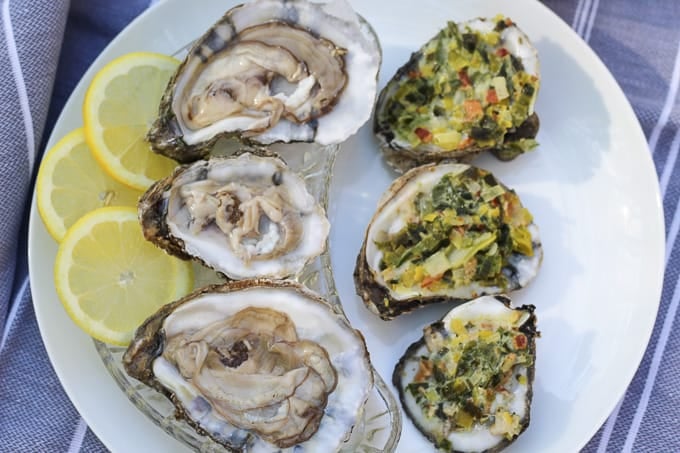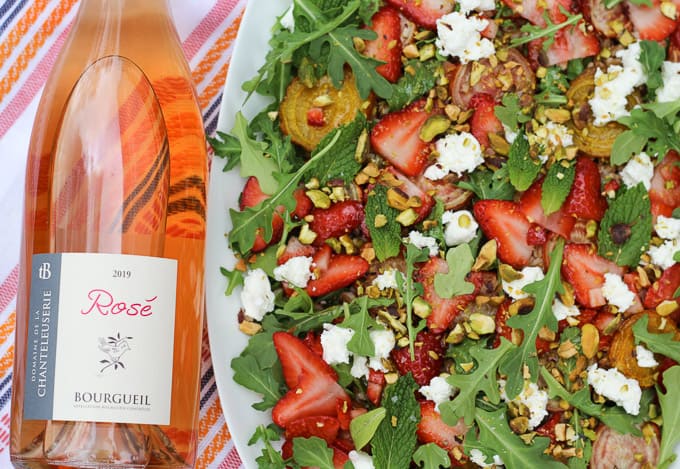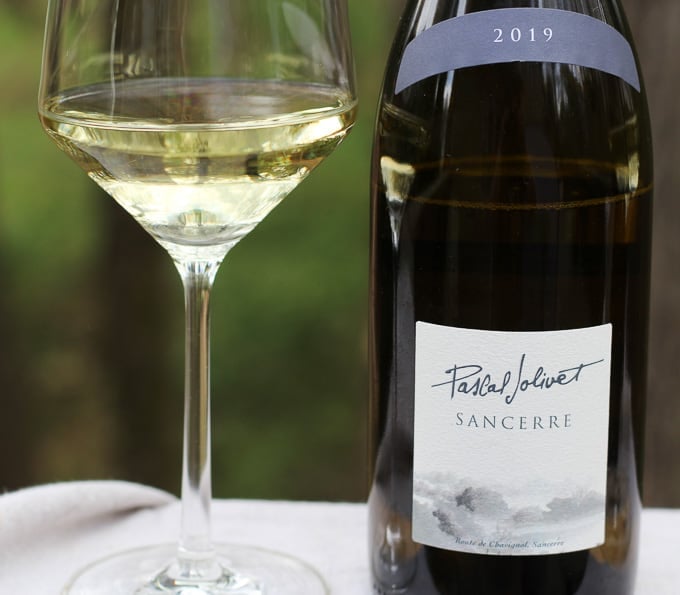
What better way to celebrate Earth Day than to take a virtual tour of the Loire Valley wine region known as The Garden of France and The Heart of France’s Organic/Biodynamic/Natural Wine Movement. This wine-growing region is France’s largest white wine region, second largest sparkling producer, and third largest overall producer of Appellation d’Contrôlée (AOC) wines. I’ll introduce you to a few of the Loire Valley’s principal grape varieties with my tastings and pairings below.
This month the French Winophiles are exploring the Loire Valley wine-growing region. Join us for our chat on Twitter, Saturday, April 17th, 2021, at 11:00 AM ET (using hashtag #winophiles), and don’t miss more articles from the group at the end of this post.

map courtesy of www.ExperienceLoire.com
The Loire Valley wine-growing region is located in Central France along the Loire River. It is the most diverse wine region in France, with approximately 70 Appellation d’Contrôlée (AOC) producing dry, sweet, and sparkling white wines, red wine, and dry and semi-sweet rosé. The Loire Valley’s northern location at 47º latitude (Champagne is 49º) makes it one of the cooler climates for grapes to ripen. These lower temperatures often results in delicate, fresh wines with high acidity, ideal wines for food pairings.
Loire Valley’s Four Wine Growing Regions
1. Pays Nantais (Lower Loire) – This is the most western sub-region near the city of Nantes. This region is known for Muscadet (also known locally as Melon de Bourgogne). Look for Muscadet aged sur lie from the Muscadet Sèvre Maine AOC.
2. Anjou, Saumur, and Touraine (Middle Loire) – This region is dominated by Chenin Blanc and Cabernet Franc. Anjou is located near the town of Angers and half of its wine production is rosé. Saumur is the largest sparkling wine producer in the Loire Valley. Touraine is located around the town of Tours. It has the most varied wine styles from dry, sweet, rosé, and sparkling. The climate is more continental, and therefore, cooler. Look for wines from Savennières AOC, Rosé d’ Anjou AOC, Vouvray AOC, Chinon AOC, Bourgueil AOC, just to name a few.
3. Centre Loire – This region produces Loire’s most well-known wines. The main grape varieties are Sauvignon Blanc and Pinot Noir. The climate is continental, with the most significant seasonal temperature swings. Two of the most well-known AOCs, Pouilly-Fumé and Sancerre, both are producing Sauvignon Blanc.
4. Upper Loire – This region produces Chardonnay and Sacy white wines and red and rosé wines from Gamay and Pinot Noir. Rarely are these wines seen outside of France.
My Wine Tastings and Pairings

2019 Domaine de la Pepiere, Muscadet Sèvre et Maine sur Lie (Lower Loire)
12% abv | $18.00 | 100% Muscadet
Domaine de la Pepiere was founded in 1984 by Marc Ollivier. His goal is to create wines that express the terroir in which the grapes grow. The entire estate is certified in organic farming and is in the process of becoming certified for biodynamics.
The wine is produced from 12-hectares of vineyards located on the hillside of the Maine River. The subsoils are granitic with lots of filtering gravel. The average age of the vines is 25 years old. The grapes are hand harvest, fermented with indigenous yeasts, and aged on their lees in stainless steel tanks until spring.
Pale straw in color with medium body and medium (+) acidity. Aromas of seashells, lime zest, green apple, and minerals. On the palate, dry, with flavor notes of lime zest, saline minerals, green apple, and yeast. Crisp and refreshing, with a soft round texture.
Food Pairing: This is a classic wine to serve with oysters or any light seafood or poultry. I had oysters two different ways; raw with just a squeeze of lemon and roasted à la Rockefeller with melted leeks, pancetta, and Pernod creme. The raw briny oysters echoing the lightness and saline minerals of the wine. The roasted version mimics the round texture of the wine from the sur lie aging while balancing the wine’s refreshing crisp acidity. Both ways were a match made in heaven!


2019 Domaine de la Chanteleuserie Rosé Bourguiel, (Middle Loire – Touraine)
14.4% abv |$17.00 Kermit Lynch |100% Cabernet Franc
Domaine de la Chanteleuserie is located outside the village of Benais, in the heart of Touraine. The estate was originally established in 1819, now owned by the seventh generation, Thierry and Christine Bouchard. Since 2000 Thierry has worked the vineyards with integrated pest management and limited use of synthetic products.
The wine is produced from vineyards with an average age of 35 years. The soils are siliceous clay. The juice is fermented in stainless steel tanks without malolactic fermentation. The rosé is made by 30% saignée and 70% direct press. The final wine has no residual sugar.
Pale salmon in color with medium (+) body, medium (-) tannins, and medium (+) acidity. Aromas of stone fruit, red berries, wet stones, and dried herbs. On the palate, dry with flavor notes of wet stones, strawberries, nectarine, and dried herbs. It is well structured with a savory element and a lingering finish.
Food Pairing: This strawberry, roasted beet, arugula, goat cheese, and farro salad play to the similar characteristics found in the wine; strawberries, earthy-sweet roasted beets, and herbs. The higher alcohol and body of the wine is balanced with the weight of the farro. The creamy, tangy goat cheese pairs well with the wine’s acidity. The perfect salad for this Middle Loire Rosé.


2019 Domaine Pascal Jolivet Sancerre
13.5% abv | $27.00 Total Wines | 100% Sauvignon Blanc
Domaine Pascal Jolivet was established in 1993 with the purchase of 15 acres of vineyards in the Buéen- Sancerre: Le Chêne Marchand, Le Grand Chemarin, and La Plante des Prés. In 1995 Jolivet’s first Pouilly-Fumé vineyard of 16 acres was purchased in Tracy-sur-Loire. Today the estate includes a total of 104 acres in Sancerre and 20 acres in Pouilly-sur-Loire. Together these 124 acres produce 50% of the whole domain; the remaining 50% is supplied from growers since the 1980s. Domaine Pascal Jolivet practices biodynamic winemaking using indigenous yeasts, maturation on lees, slow fermentation, and very low levels of sulfur. In 2016, Jolivet partnered with Benoit Dauny, a pioneer in organic viticulture, to supervise the organic farming of the Domaine Pascal estate vineyards.
The Pascal Jolivet Sancerre is sourced from three vineyards in the appellation. The “Les Caillottes” vineyard, with its chalky soils, makes up 50% of the blend, followed by 30% from “Les Terres Blanches,” a hillside vineyard composed of clay and limestone, and 20% from the “Silex” vineyard of limestone and flint. (Limestone brings minerality and finesse, limestone-clay enhances the fruit and richness, and flint provides structure and minerality.)
Pale straw in color with a green hue, medium body, and medium (+) acidity. Aromas of fresh citrus and minerals. On the palate, dry with refreshing notes of grapefruit and minerals.

2019 Pascal Jolivet Les Franches Pouilly-Fumé
13.5 % abv | $40.00 Total Wines | 100% Sauvignon Blanc
In 1987, Pascal Jolivet as a winemaker and merchant, established the “Pascal Jolivet” brand. Pascal built his first winery in 1990 in the heart of Sancerre on a one-hectare site called “Les Franches.” This wine selects the best terroirs of Pouilly-Fumé with chalk, clay, and silex soils.
Pale straw in color with a green hue, medium body, and medium acidity. Aromas of citrus, flint, smoke, and white pepper. On the palate, dry with notes of citrus, minerals, flinty smoke, and a round, creamy texture.
Food Pairing with the Sancerre and Pouilly-Fumé: Sauvignon Blanc makes for a lovely aperitif wine and a wine to pair with appetizers. My favorite foods to pair with Sauvignon Blanc are vegetables and herbs. These zucchini cornmeal cakes are loaded with zucchini and topped with a herb-packed chutney and a dollop of Greek yogurt. The acidity, citrus, and mineral notes of both Sauvignon Blancs highlight and complement the fresh vegetables, herbs, and pan-fried crisp zucchini cakes.


Strawberry, Roasted Beet, Arugula, Goat Cheese, and Farro Salad
Ingredients
- 1 lb. small beets, unpeeled I used mixed colors of beets
- 5 tablespoons, divided extra virgin olive oil
- kosher salt
- 3 tablespoons white balsamic vinegar
- 1 tablespoon maple syrup
- 1 tablespoon freshly squeezed lemon juice
- 3 tablespoons fresh strawberries, diced
- 10 strawberries, cored and sliced
- 1-1/2 cups farro, cooked
- 4 cups baby arugula
- 1/4 cup pistachio nuts, roasted and slightly crushed
- 2 oz fresh young goat cheese, crumbled
- 1/4 cup baby mint leaves
- sea salt flakes for finishing I like "Maldon"
Instructions
- Preheat the oven to 450 degrees F. Line a baking sheet with parchment paper.
- Trim the ends off of the beets and slice them in 1/4-inch thick slices. If you have multiple colors of beets, toss them separately by color in a total of 2 tablespoons of olive oil and 3/4 teaspoon of salt.
- Arrange the beet slices on the baking sheet in a single layer, separately by color. Bake for about 15-18 minutes, rotating the baking sheet half way through the baking time.
- In a small bowl, whisk together the remaining 3 tablespoons of olive oil, the white balsamic vinegar, maple syrup, lemon juice and a big pinch of salt. Stir in the diced strawberries and set aside.
- In a medium bowl, put the cooked farro and season with a 1/2 teaspoon of salt. Stir in 2 tablespoons of the strawberry dressing and mix to combine. Set aside for 10 minutes so the farro can absorb the dressing.
- To serve: use four dinner plates or a large oval platter. Divide the arugula between the dinner plates or on the large platter. Drizzle the arugula with 2 tablespoons of the strawberry dressing and sprinkle with a few sea salt flakes. On top of the arugula, arrange the beet and strawberry slices and the farro. Drizzle with the remaining dressing and then top with the goat cheese crumbles, and pistachios and mint leaves.

Zucchini Cornmeal Cakes with an Herby Chutney and Yogurt
Ingredients
For the Zucchini Cornmeal Cakes
- 3 small zucchini, grated, (3 cups)
- kosher salt
- 1/2 cup fine cornmeal
- 1/2 cup all-purpose unbleached flour
- 1 teaspoon baking powder
- 1/2 teaspoon baking soda
- 1 teaspoon fresh thyme leaves
- 2 large eggs
- 3 tablespoons unsalted butter, melted
- 5 small scallions, (white and light green part) minced
- 1 small garlic clove, minced
- extra virgin olive, for frying
- sea salt flakes for finishing I like Maldon sea salt flakes
For the herby chutney
- 2 cups fresh mint leaves
- 1 cup fresh cilantro leaves
- 1 cup Italian parsley leaves
- 1/4 medium jalapeño
- 2 small garlic cloves, minced
- 2 tablespoons fresh lime juice
- 1 small shallot, chopped
- kosher salt
- plain Greek yogurt for serving
Instructions
- In a large colander, toss the grated zucchini with 1/2 teaspoon of salt. Place the colander in a large bowl and let drain for about 10 minutes.
To Make the Zucchini Cornmeal cakes
- In a large bowl, combine cornmeal, flour, baking powder, baking soda, thyme leaves, 1/2 teaspoon salt. Whisk together to combine.
- In a small bowl, whisk together the eggs and melted butter.Add this egg mixture to the cornmeal mixture and stir to form a thick batter.
- Squeeze as much moisture as possible out of the salted zucchini. Add the zucchini, scallions, and garlic to the batter. Gently fold to combine.
- In a large frying pan over medium heat, and just enough olive oil to coat the bottom of the pan. When the oil is hot, add 2-tablespoon size balls (I use a spring loaded ice cream scoop) of the zucchini batter to the frying pan. Flatten the balls with a metal spatula, form a single layer without the pancakes touching each other.
- Fry them for about 3-4 minutes per side and transfer to a paper towel lined baking sheet to drain. Sprinkle with sea salt flakes. And repeat with the remaining batter.
To Make the herby chutney
- In a mini food processor, combine the mint, cilantro, parsley, jalapeño, garlic, lime juice, shallot, salt and 2 tablespoons of water. Process until smooth adding more water if needed.
- Serve the zucchini cakes with the herby chutney and plain Greek yogurt.
Sources:
“Perfect Pairings,” Evan Goldstein
“The Wine Bible,” Karen MacNeil
Wine Scholar Guild
Domaine de la Pépière
Kermit Lynch
Domaine de la Chanteleuserie
Domaine Pascal Jolivet
More On the Loire Valley Wine Region from the French Winophiles
-
Susannah Gold brings “Vouvray – A Wine In Many Styles” to Avinare.
- Nicole Ruiz Hudson does “Cooking to the Wine: Domaine Huet Vouvray Clos du Bourg Moelleux & Pork Tenderloin with Citrus Gastrique” on Sommstable
-
Jane Niemeyer suggests “Tasting and Pairing Loire Valley Wines” on Always Ravenous
-
Linda Whipple shares “Organic Muscadet and must-have oysters” at My Full Wine Glass
-
Terri Steffes invites you to “A Tasty Dance: Red Beans and Rice with Les Parcelles Mark Dupas Sauvignon Blanc” on Our Good Life
- Andrea Lemieux offers “Pascal Jolivet & Sancerre the Way Nature Intended” on The Quirky Cork
- Cam Mann has “Porc aux Pruneaux (Pork with Prunes) + Chateau de Parnay Le Blason de Parnay 2018” on Culinary Adventures with Camilla
- Host Gwendolyn Alley on Wine Predator shares “Loire’s Biodynamic Manor Tete de Rouge For Unusual Reds”

What a great selection of wines! So envious of the Muscadet, always wanted to try one.
I am studying for the French Wine Scholar certificate so I took a deep dive into tasting Loire Valley wines. Don’t give up on trying to track down a Muscadet, I am a total fan of Domaine de la Pepiere!
Love Muscadet and was so happy to find an organic one for this month’s theme. I will be saving the salad and corncake recipes – both are my kind of dishes!
Muscadet is the perfect wine going into the warmer temperatures and always with oysters!
Great selection of wines! Funny enough, I know most of these really well having drank them often or sold them when I was working at a wine store. The la Pepiere in particular is such a good value and you’re right, sooooo good with oysters. Those zucchini cornmeal cakes also look awesome!
I have definitely become a fan of the Loire Valley wines and La Pepiere, they are food-friendly and a great value!